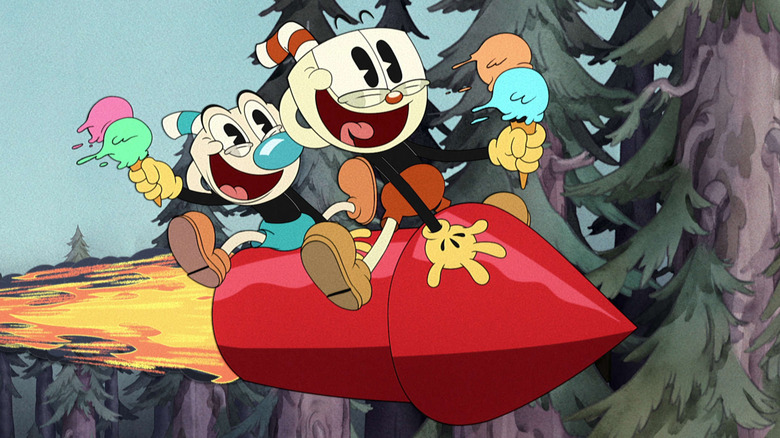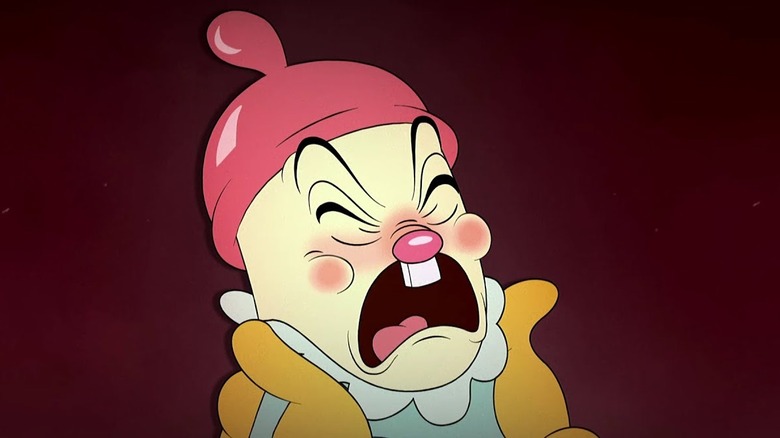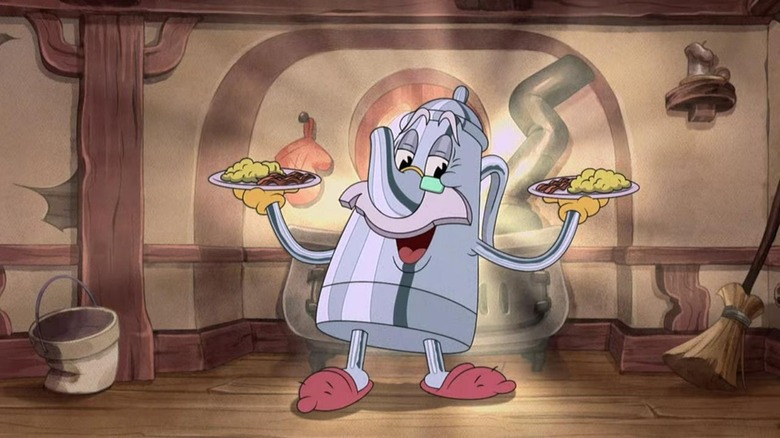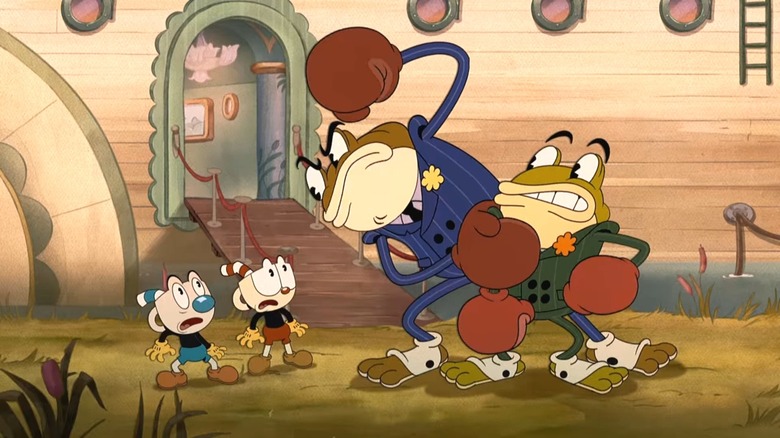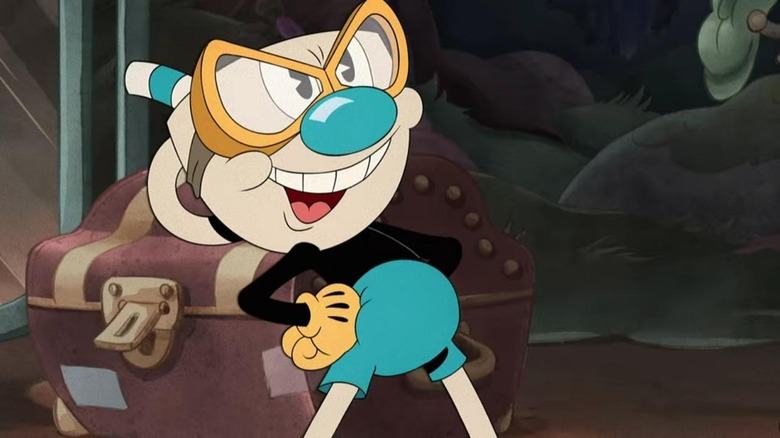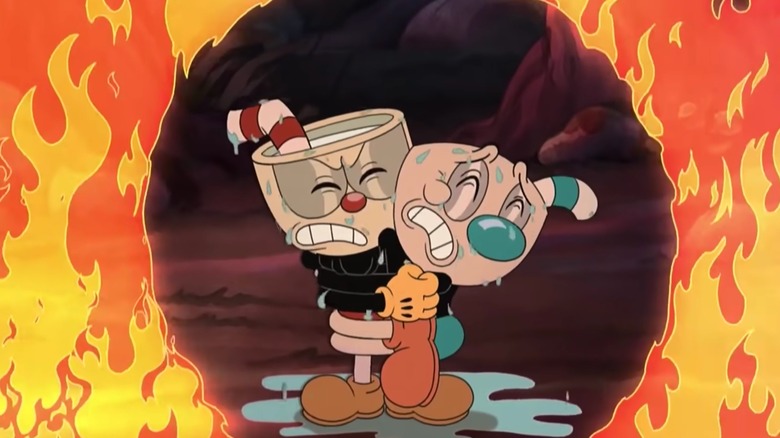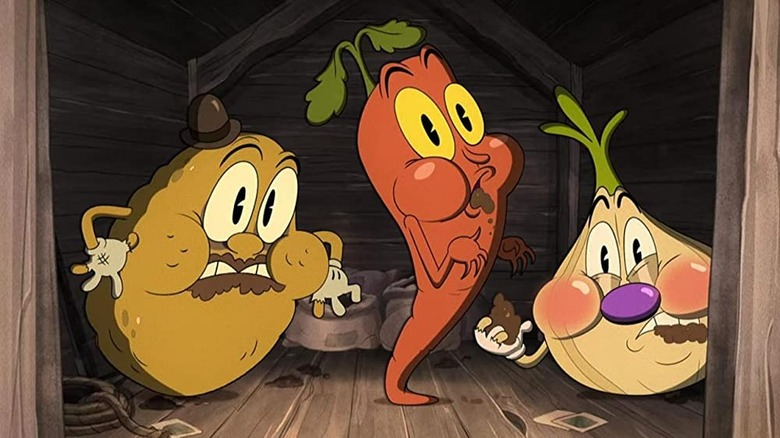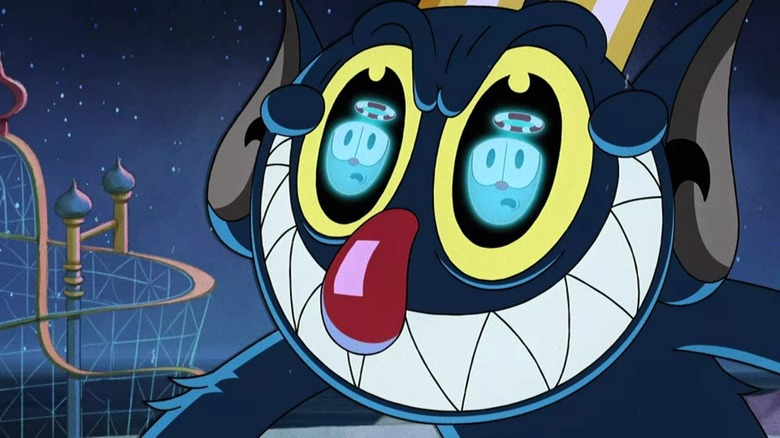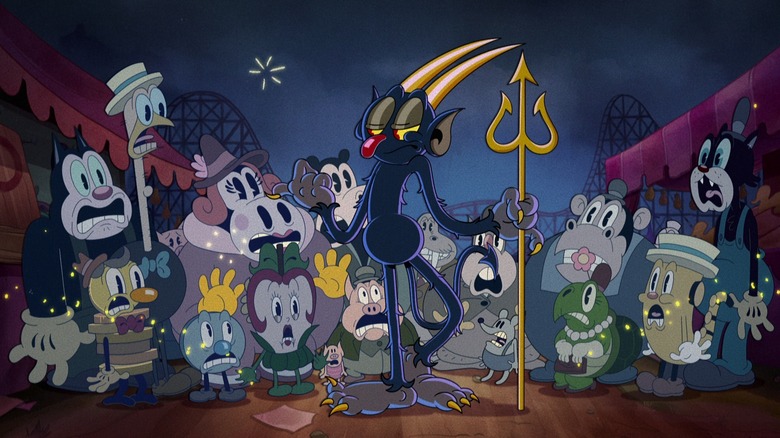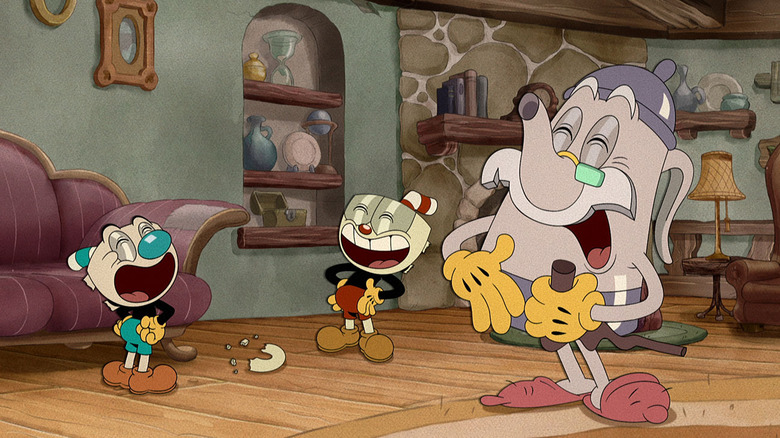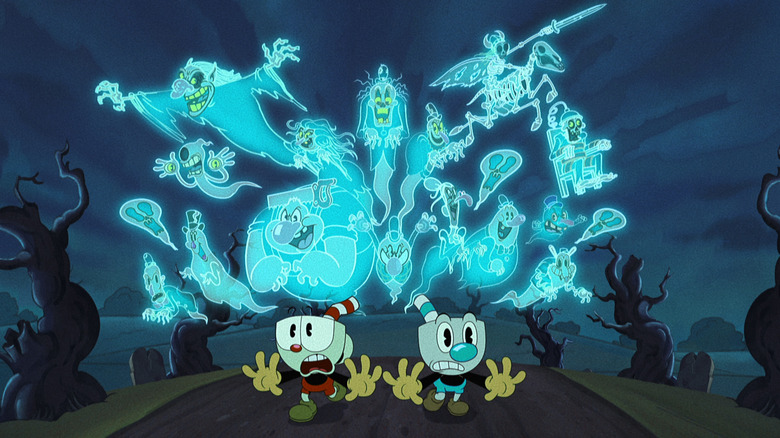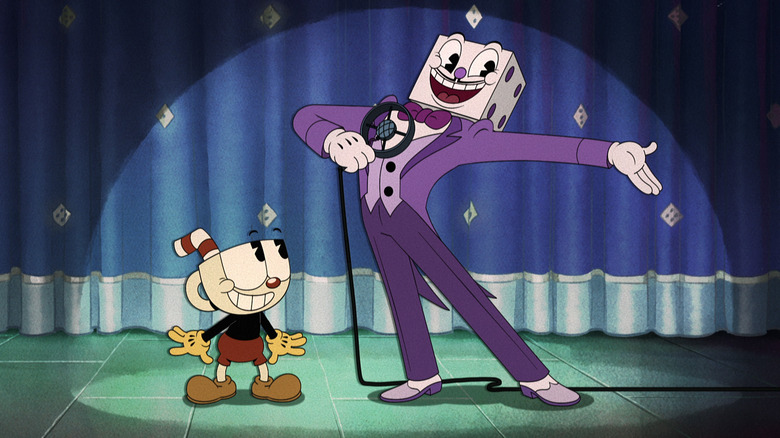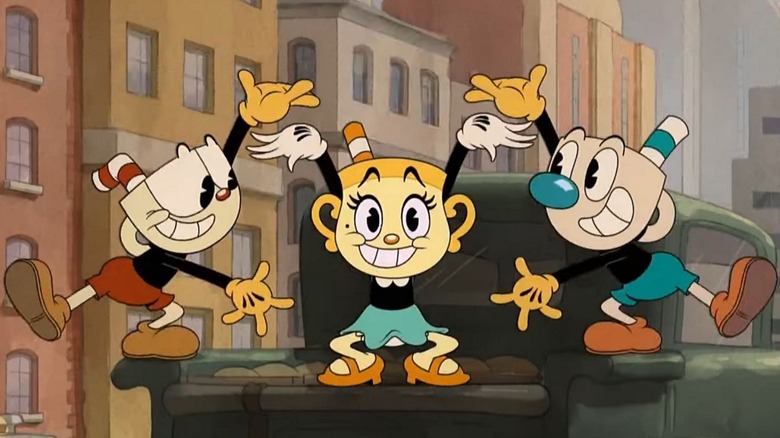The Cuphead Show Season 1 Episodes Ranked
Now here's a real high-class cartoon! Based on the beloved and bestselling 2017 video game, "The Cuphead Show!" is Netflix's latest animated adaptation from the interactive medium, following previous outstanding efforts like "Castlevania” and last year's "Arcane." But unlike those shows, the ceramic superstar's series is aimed at a much younger audience, embodying the 1930s rubber-hose art style of its source material while playing out like a modern iteration on the shows that defined Saturday mornings in decades past.
Three years after the announcement for the animated series, "The Cuphead Show!" finally arrived with a 12-episode debut season (with a second season due this summer). Despite a mixed reception from critics, the show has been widely embraced by animation aficionados and "Cuphead" connoisseurs alike. Not every episode hits, but on the whole, Netflix Animation has successfully translated Studio MDHR's passion project to the small screen. The following list ranks each Season 1 episode of "The Cuphead Show!" from weakest to strongest.
12. Baby Bottle
Despite what many of the show's critics imply, there's absolutely nothing wrong with "The Cuphead Show!" ignoring branching storylines in favor of 15-minute standalone hijinks (the animation of Ub Iwerks and the Fleischer Brothers were never known for sequential storytelling either, after all). However, after a solid pilot episode introducing Cuphead, Mugman, and the Devil himself, it likely didn't give critics a lot of confidence in the show when the follow-up turned out to be far-and-away the least entertaining episode of the season.
"Baby Bottle" abandons any and all continuity and features an entirely self-contained slapstick story centered around a character original to the show — in this case, an anthropomorphic baby bottle anonymously delivered to Cuphead and Mugman's house. The episode's humor is stilted, its premise is weirdly contrived, and it ends without much actual resolution. "Baby Bottle" isn't a terrible way to spend 15 minutes, but it gives the impression the show's writers had already run out of ideas by the second episode.
11. Dirt Nap
Despite his frequent attendance on "The Cuphead Show!" Elder Kettle had an extremely limited presence in the original title, bestowing Cuphead and Mugman their magical offensive abilities at the journey's outset and little else. Since the show isn't following the events of the game (for now, anyway), what's the franchise's father figure to do but adopt the most classic tropes of his cartoon-character archetype? Incidentally, his lone central episode in the show's first season also has a similar perspective: Worried he's aging into irrelevance, Elder Kettle overhears his surrogate sons "plotting" to dispose of their rusty guardian, leading Elder Kettle to spiral into a bout of extreme paranoia, even though it becomes clear something's been lost in translation.
"Dirt Nap" is a good old-fashioned sequence of literal misunderstandings and exaggerated projection, building a conflict completely out of nothing. It's a fine story, but it feels more tired than traditional, especially given that other, better episodes usually carry a unique beat to catch audiences off-guard. Joe Hanna is lovely as Elder Kettle as always, and the hints at the old can's decorated past are fascinating. Even so, "Dirt Nap" is a disposable episode that likely won't leave any lasting impressions.
10. Ribby & Croaks
Unlike many modern adaptations of popular nerdy media, "The Cuphead Show!" demonstrates surprising restraint in its fanservice throughout its first season. Many of the game's most iconic bosses, like Grim Matchstick, Cala Maria, and Beppi the Clown, are delegated to blink-and-you'll-miss-it cameos. Two episodes do indulge in the source material's wide array of big baddies, however, and the first of the pair is dedicated to the most infamous duo on the Inkwell Isles: Ribby and Croaks, the street-fighting frogs.
Distinguished from the rest of the season's supporting cast, Ribby and Croaks are imbued with light thematic weight, as their highly combative brotherhood mirrors Cuphead and Mugman's, serving as the central internal obstacle for the boys. Unfortunately, the episode is dampened by a below-average musical number — a recurring problem throughout the season — in which the frogs lament their dearly-departed mother. Chaos does break out in their buoyant and bougie ferry, akin to the game, but the slight similarities only underscore the glaring inaccuracies (the frogs wearing actual clothes, for example). Ribby and Croaks are fun, but their debut episode is also a half-measure in the small catalog.
9. Dangerous Mugman
Initially designed as a humble avatar for any and all potential player 2s, Mugman's depiction in "The Cuphead Show!" matches the more cautious and timid characterization he embodies (in a single line of dialogue) in the original game, striking a chord similar to Nintendo's Luigi, the most famous brother in gaming. In that sense, it's no surprise Mugman's starring episode features a fairly standard lightweight character arc. Tasked with a certifiably dangerous errand from the irritable shopkeep, Porkrind, the blue brother finds unexpected bravery in a pair of goggles modeled after Dirk Dangerous, a Dick Tracy-esque radio drama character whom the boys idolize.
"The Cuphead Show!" is at its weakest when it reuses tired scenarios. In this case, a timid character adopts a new sense of courage upon wearing an item of clothing. The moment that elevates the episode from being a complete drag is when Cuphead consciously decides to be a supportive brother, ranking among one of the most genuine moments of the season (and it's not the only one, thankfully). Topped off with a surprise cameo at the end, "Dangerous Mugman" sits comfortably in the show's qualitative midpoint between aggressively adequate and surprisingly solid.
8. Sweater Off Dead
There's something unique about watching a cartoon as fun and fancy-free as "The Cuphead Show!" without fully understanding the intent behind a central story beat. Such is the case with "Sweater Off Dead," which hinges on a distractingly bizarre premise. Noticing his brother's increasing anxiety, Mugman seeks out the mystical Quadratus (who appeared in the game to inform players of their total death count) who instructs the concerned brother to knit a Devil-warding sweater ... out of invisible yarn. The sweater itself doesn't require narrative explanation, but conceptually, it provokes more external questions: Is the invisible sweater an animation in-joke? A reference to a relic of the rubber hose era? Or simply a random scenario?
This lack of context doesn't hurt the episode too badly, which features plenty of delicious devilry and climaxes with the best narrative payoff of the season. It just feels like some vital information is missing; the invisible sweater itself only inspires light confusion, which distracts from what is otherwise a good time. Though it's an experience exclusive to this lone episode, it just so happens to be the only one with a direct follow-up, exacerbating the dilemma.
7. Root Packed
Right alongside Ribby and Croaks, The Root Pack are among the first batch of bosses Cuphead and Mugman face in the original "Cuphead," as a trio of powerful perishables loosely based on The Three Stooges. Sal, Ollie, and Chauncey may not be exact recreations, but they still embody the same troublemaking attitude as a group of freeloaders who scour the land for gardens to inhabit. In this episode's case, they take up root in Elder Kettle's garden, sucking it dry and organizing an anthropomorphic veggie celebration that would make Larry the Cucumber and Bob the Tomato from "VeggieTales" blush.
Fittingly, "Root Packed" is defined by its titular gang of nutritional transient tricksters, even if their slight redesigns mean less interesting visual charm (Chauncey's signature psychic powers are completely absent, for example). It's also one of two times in the season in which composer Ego Plum dips into Kristofer Maddigan's sensational soundtrack from the original game — the other being "Ribby & Croaks" — diegetically incorporating "Botanic Panic," The Root Pack's very own battle music, as the big band jazz piece from a group of vegetables during the party. It's a lovely tribute in a solid episode.
6. Sweater Luck Next Time
The second half of the "Sweater" arc, "Sweater Luck Next Time" uses the scenario and stakes set up in the previous episode to explore new avenues of the franchise's mythology. Instead of Cuphead and Mugman challenging the Devil in his hellish home, the complete reverse occurs, and for franchise fans, seeing the Devil at Cupsy's door might be enough to send their souls upward.
In fact, "Sweater Luck Next Time" repeatedly plays with expectations, including standout moments like the Devil performing a Fantasia-esque sequence in painting Elder Kettle's fence and the two most diametrically-opposed characters becoming friends while in line for a theme park ride. Ironically, though it's the only sequential episode of the bunch, it doesn't end with any lasting plot or character development outside of a more permanent solution to the Devil's repeated attempts at Cuphead's soul. The brief moment of friendship between the two was surprisingly refreshing. Hopefully, this isn't the last time the show kicks back and lets its cast ease up on their roles as heroes and villains.
5. Carn-Evil
"The Cuphead Show!" starts off on a strong note, debuting its main characters and lively world with a fun premise and stunning animation. Naturally, the pilot introduces Tru Valentino, Frank Todaro, and Joe Hanna as Cuphead, Mugman, and Elder Kettle. As they prove throughout the rest of the season, the three are exceptionally cast, bringing so much life and energy into their characters. Their performances are helped by their buttery smooth and bouncy movement.
The three central voice actors (and the rest of the cast) are completely outdone, however, by Luke Millington-Drake's star-making turn as the Devil, whose soul-sucking carnival marks Cuphead a target for spiritual debt collection. Millington-Drake's preening and leering delivery is delightful, calling back to other cartoon caricatures of Old Scratch, such as Him from "The Powerpuff Girls." Even his old-timey musical number is fun, as it's one of the only songs in the season that actually sounds like a product of early 20th Century American music. Like any good TV pilot, "Carn-Evil" impresses in the present and sows the seeds of a promising future.
4. Handle With Care
The first season of "The Cuphead Show!" features three stay-at-home episodes, in which the brothers and their watchful guardian spend the majority of the runtime in their humble abode. Given that two of them are the weakest episodes of the season, it's surprising that the third of the bunch is so strong. The difference is originality: The lower-ranking episodes are hampered by predictability, whereas "Handle with Care" is a unique offering — it's about its main characters' biology, after all! The story follows Cuphead and Mugman after the latter accidentally breaks the handle attached to the back of his head, and the pair rush to find the appropriate means to reattach it.
On its own, Mugman losing his handle reads like an existential nightmare. Does it hurt? Is it like losing a limb? Are there vital organs stored in there? Regardless, the show treats it as a light injury with huge social condemnation. The escapades culminate in a legitimately surprising resolution that feels different from how most cartoons resolve their conflicts. Instead of coincidence or simplicity, what if they already had the answer? "Handle with Care" is the perfect self-contained episode.
3. Ghosts Ain't Real!
If any singular episode of "The Cuphead Show!" represents its success in simplicity, it's Cuphead and Mugman's impromptu overnight stay in a local graveyard. Featuring the dark imagery and thick shadows of '30s animation classics — including a copyright-friendly recreation of Ub Iwerks' and Walt Disney's debut Silly Symphony short, 1929's "The Skeleton Dance" — "Ghosts Ain't Real!" is nothing short of spectacular, in the most traditional use of the word. From ghoulish hallucinations to creepy background art, the most potent part of the rubber hose era is given full, unfiltered representation.
Elevating the art is the inclusion of stereoscopic radial processing, infusing the show's smooth 2D animation with gorgeous clay-model backgrounds, courtesy of studio Screen Novelties. The original game used similar techniques, but never to such an extent, making "Ghosts Ain't Real!" the only time that the "Cuphead" show outdoes the "Cuphead" game. The only thing holding back the episode from taking the top spot is the plainly forgettable musical number permeating throughout (even if it ends with one of the most emotionally arresting moments the show has to offer). Still, even the most frequent issue of the season can't hinder this spooky showstopper.
2. Roll the Dice
As essential to the "Cuphead" franchise as the Devil himself is, King Dice was the most recurring character in the game, keeping tabs on Cupsy and Mugsy during their debt collection across the Inkwell Isles. Despite his iconic design, theme song, and narrative importance, King Dice only appears in one episode of the show, trading out a demonic casino for a radio-based game show. However, it's likely fans of the Devil's right-hand man won't mind too much, considering it's the funniest episode of the season by far.
When Cuphead and Mugman stumble into Dice's studio, the host sees a golden opportunity to steal Cuphead's soul for his boss. What Dice doesn't realize is that his boss' impromptu nemesis is an unassuming agent of chaos, whose unregulated excitement and lack of basic intellect amount to an incredible series of blunders. The episode has small ambitions, but prevails with some of the best wordplay and slapstick of the season, all accentuated by real-life game show host legend Wayne Brady as King Dice.
1. In Charm's Way
First seasons are tricky. They're built to give a positive first impression, yet almost never reflect the show's highest moments, in retrospect (with exceptions like "Stranger Things" and "Westworld"). "The Cuphead Show!" had a solid debut overall, but if the season finale is any indication, it's only going to get better from here. "In Charm's Way" introduces Ms. Chalice, a recurring side-character in "Cuphead" (and the third playable character in the game's upcoming downloadable expansion, "The Delicious Last Course"). Though the Inkwell Isles host a handy helping of memorable residents, the wayward Chalice resides in a league of her own, demonstrating unparalleled depth and dimensionality.
Upon meeting the brothers, Chalice agrees to teach them how to charm their troubles away. Though suspicious of them at first, she quickly befriends the two before an unforeseen obstacle shows the brothers where her conflicted priorities lie, ending the season on a captivating cliffhanger. It's the only episode with a musical number that benefits the experience, helped by a great performance from voice actor Grey Griffin as Chalice. "In Charm's Way" isn't just the finest episode of "Cuphead's" debut season on television — on its own merits, it's a knockout!
